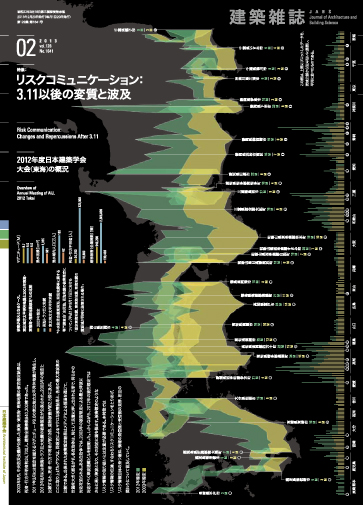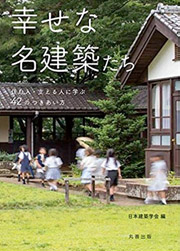本文PDFの閲覧につきましては、こちらでご確認ください。

2013-2月号 FEBRUARY
特集= リスクコミュニケーション
─ 3.11以後の変質と波及
Risk Communication─ Changes and Repercussions After 3.11
特集前言 ゼロと最大の間に広がる連続的世界の複雑さ
3.11は、リスクコミュニケーション(以下、リスコミ)を大きく変質させた。同時に、この変質が波及する裾野も極めて広い。本号はこうした諸問題にフォーカスした小特集である。
例えば、文化財に指定されていない建築物の保存を社会に訴えるとき、所有者、近隣住民、自治体や国の間で理解を共有するのに、幅広い知識とリテラシーと時間が必要になることは容易に想像できる。件の建物の価値が、万人の納得するものでなく、また、ゼロでないことも明らかなとき、コミュニケーションの必要性は明らかだ。
ところが災害の場合、それが生命の危険に直結するからこそ、私たちの防災技術・制度は「ゼロリスク」を目標とするのが自明で、現実の構築環境もほぼそれを達成しているだろうという漠然とした思い込みが生じやすい。第1部の基礎論編で遠藤靖典氏が述べるところによれば、「ゼロリスク志向はまずい」という意識が国民レベルで広まったのは3.11以後である。
「ゼロ」がありえないことを認めたとき、「コミュニケーション」の地平が開かれるが、実際には多くの障壁がある。ともすれば国家レベルでゼロリスクが再び志向される危険性を遠藤氏は示唆しているし、広田すみれ氏も3.11はリスコミの可能性を開く一方で、行政への不信、報道の偏り、専門家の防衛的姿勢などの「後退」ももたらしたことを懸念する。上市秀雄氏には、情報の送り手が伝達に伴う多様なバイアスを知るとともに、送り手としての倫理をわきまえる必要性を解説していただいたが、受け手側のリテラシーの基礎となる「ニューメラシー」教育の必要性という広田氏の指摘も興味深い。
3.11以後、内閣府は南海トラフ地震の従来の被害想定を見直し、起こりうる最大規模の被害想定を公表した(2012年のいわゆる3.31発表と8.29発表)。田中淳・森保宏の両氏による対談では、この見直しの背景と意味、またそれが従来の想定に基づいて対応を積み重ねてきた地域社会にもたらしている混乱をどうとらえるべきか、そして、ゼロと最大の間に広がる連続的な世界の複雑さを扱うための思想と方法が幅広く議論されており示唆に富む。
続けて、南海トラフ地震の被害想定の見直しが地域社会にどのような対応を迫っているかをインタビューでとらえる。高知県黒潮町と和歌山県串本町については自治体の担当者に話を聞いた。松本敏郎氏によれば、最大波高34mという想定に一時は大混乱が生じた黒潮町では、まず「ブレない思想」をつくることから始め、具体的な対策を段階的に着実に進めている。串本町では3.11以前から合併を機に公共施設の高台集約を進めていることを濵地弘貴氏に紹介いただいた。3.11以降、行政に対しては避難路整備の要望が噴出する一方で、防潮堤建設の要望はないなどの事実も興味深い。他方で建設業界もさまざまな対応に迫られている。ここでは西影武知氏に、大阪の構造設計者の立場から、南海トラフと上町断層という発生周期も性質も異なる二つの地震をめぐって、施主と設計者、あるいは構造設計者と意匠・設備設計者の間に生じるコミュニケーション上の諸問題を語っていただいた。
次に、翻ってより一般的に建築専門家の対応状況をみる。まず、坂本成弘氏には本会の各委員会・WGなどによる建築業界でのリスコミの対応状況の把握、基本問題の把握、性能設計の考え方に基づくコミュニケーション・ツールの整備といった取組みを紹介いただいた。常木康弘氏によれば、建築物の構造設計においても法的基準の遵守がそのままゼロリスクを保証しているかのような社会的認識のなかで、リスコミへの対応が必ずしも進んでいないこと、地震動の想定も、それに対する建物の振動も十分には確定できないなかで、各学業会、各社でのツール開発が試みられている。
最後に、リスコミを支えるメディアに着目した。井上智広氏には、地震学を専攻してNHKでTV番組制作に携わる立場から、科学・工学と市民との間に開いた溝とそれを埋めるうえでのマスメディアの役割について、また、藤本一雄氏には自治体におけるハザードマップ作成の現況とそれが有効に働くための課題について執筆いただいた。
会誌編集委員会
本号編集担当:蜷川利彦(九州大学)・加藤研一(小堀鐸二研究所)・村尾修(筑波大学)
[目次]
| 000 | 連載 再建への意志:図面のなかの都市復興 大火後のロンドン再建プラン群/東辻賢治郎 |
| 002 | 連載 東日本大震災|連続ルポ1|動き出す被災地 被災を超えて地域の歴史文化を受け継ぐ試み─気仙沼市の二つの事例から/三浦卓也 + 田揚裕子 |
| 004 | 連載 東日本大震災|連続ルポ2|仮すまいの姿 復興のその先に向けたコミュニティ・デザイン─あすと長町仮設住宅(仙台市)での取組み/新井信幸 |
特集 リスクコミュニケーション:3.11以後の変質と波及
| 006 | 特集前言 ゼロと最大の間に広がる連続的世界の複雑さ |
| 008 | ゼロリスクは幻想である─被災の可能性について認知する/遠藤靖典 |
| 010 | 次の震災が起こる前にすべきこと─市民に利益のあるリスクリテラシー教育を/広田すみれ |
| 012 | どのようにリスクを伝えればよいか─よりよいリスクコミュニケーションのために必要なこと/上市秀雄 |
| 014 | 対談 南海トラフ巨大地震被害想定とその社会的影響─リスク情報の発信と受信の隔たりをどうとらえるか?/田中淳 × 森保宏 |
| 018 | インタビュー 地震・津波と日本一うまく付き合うための防災計画(高知県黒潮町)/松本敏郎 |
| 020 | インタビュー 本州最南端の町で進む、公共施設の高台移転(和歌山県串本町)/濵地弘貴 |
| 022 | インタビュー 関西(大阪)における構造設計の実践/西影武知 |
| 024 | リスクコミュニケーションに関する学会の取組みと展望/坂本成弘 |
| 026 | 構造設計におけるリスクコミュニケーションの現状/常木康弘 |
| 028 | マスメディアは災害リスクをどう伝えるべきか/井上智広 |
| 030 | リスクマネジメントの視点から考える地震被害軽減に効果的なハザードマップ/藤本一雄 |
| 031 | 編集後記 蜷川利彦 + 加藤研一 + 村尾修 |
| 031 | 次号予告 2013年3月号|特集:「近代復興」再考:これからの復興のために |
| 032 | 特集を読んで 2012年12月号|特集:東日本大震災 復興のアポリア:居住地再建の諸問題 震災復興を進めるうえで魅力的な集合住宅とはどのようなものか/遠藤薫 災害復興は、地域づくりの社会実験/野崎隆一 |
| 033 | 連載 建築の争点 住宅のつくり手は断熱(+気密)が嫌いなのか?/野池政宏 |
| 034 | 連載 なぜ私は建築を選んだか 大きな流れ/重松象平 |
| 035 | 連載 Architect Politician 都市デザインの力でチャールストン市を再生した市長─ジョセフ・ライリー/服部圭郎 |
| 036 | 連載 地域いろいろ・多様な日本 「空き」の価値を再考する─佐賀市「わいわい!! コンテナプロジェクト」/西村浩 |
Preface to the Special Issue: The Complexity of Continuous World Expansion between Zero and Utmost Limits
3.11 broadly changed risk communication. At the same time, the range of repercussions and influence is extensive. This issue is a small feature focusing on such problems.
For example, during appeals for the preservation of buildings not designated as cultural properties, it's easy to imagine that wide knowledge, literacy, and time are needed to share understanding among owners, neighbors, autonomies, and the country. When the value of such buildings does not persuade everyone yet is clearly not zero, communication is obviously needed.
But in cases of disaster, because of the direct connection to the risk of life, it's axiomatic that our techniques and systems for disaster prevention should aim at zero-risk; thus, it's easy to develop a vague belief that actual construction environments would mostly have already achieved it. But according to Yasunori Endo, who discusses foundation theory in the opening article, the awareness that a "zero-risk orientation is not good" has commonly spread since 3.11.
When we recognize that "zero" never exists, communication horizons open, although many barriers remain. Endo points to the danger that zero-risk might possibly reoccur as an orientation at the national level, and Sumire Hirota worries that 3.11on the one hand opened the possibility of risk communication and on the other hand brought setbacks such as a mistrust of government, biased news, defensive attitudes among experts, and so on. Hideo Ueichi explains the need for information communicators to bear in mind their ethical obligations and be aware of the various biases in messages. It's also interesting that Hirota points to the necessity of numeracy education as a base of literacy on the recipients' side.
After 3.11 the Cabinet Office released the possible maximum estimates from a Nankai Trough earthquake commonly called 3.31 and 8.29 publications that revised significantly upward the former estimates. The talk by Atsushi Tanaka and Yasuhiro Mori brims with wide-ranging arguments and suggestions concerning this topic: In what light has the national estimate of damage been reviewed? How should we understand the confusion that the above damage estimate brings to local societies that have piled countermeasures based on conventional estimates? And what thinking and methods might be required to deal with the complexity of continuous world between zero and maximum?
Then through interviews we see what kinds of countermeasures might be urged for local societies by a review of damage estimates from a Nankai Trough earthquake. Concerning Kuroshiocho in Kochi and Kushimotocho in Wakayama, we had interviews with officials in autonomies. According Toshirou Matsumoto, in Kuroshiocho, where an estimated maximum-wave height of 34 meters briefly caused great confusion, locals first started making a stable policy and are gradually and steadily advancing concrete countermeasures. And Hirotaka Hamaji describes how town mergers in Kushimotocho had already been underway before 3.11 and provided a good opportunity for furthering the integration of public facilities on higher ground. After 3.11, while requests for maintaining evacuation routes have proliferated, interestingly there have been no requests for building seawalls. And yet the construction industry is also pressured for various countermeasures. Here, Taketomo Nishikage, as a structural designer in Osaka, discusses issues of communication that arise between clients and architects, or between structural designers and architectural/equipment designers, concerning earthquakes at the Uemachi Fault and Nankai Trough, where occurrence cycles and characters differ.
Next part reflects more generally on the state of countermeasures among architectural experts. First, Shigehiro Sakamoto introduces the efforts under way at each AIJ committee and working group, efforts such as to grasp the state of risk-communication countermeasures in the architecture industry, to grasp the basic issues, and to maintain communication tools in light of performance design. According to Yasuhiro Tsuneki, countermeasures in risk communication have not always been improved by a social understanding that legal standard compliance "fully guarantees" zero-risk in buildings' structural designs, and as for estimates of earthquake ground motion, while consequent building vibrations cannot be sufficiently determined, every study group and company is trying to develop tools.
The last part directs attention to the media that supports risk communication. Tomohiro Inoue, who majored in seismology, writes from his position involving TV production at NHK about the media's role in bridging gaps between science/engineering and the common people, and Kazuo Fujimoto writes about the present state of making hazard maps at autonomies and about their effective function.
Editorial Board
This issue has been edited by Toshihiko Ninakawa (Kyushu University), Kenichi Kato (Kobori Research Complex, Inc.) and Osamu Murao (University of Tsukuba).
[Contents]
| 000 | [Series] The Resolve to Rebuilding: City Reconstruction in Blueprint The Plans for Rebuilding the City of London after the Great Fire / Kenjiro Totsuji |
| 002 | [Series] Great East Japan Earthquake Serial Report 1 Devastated Areas Have Just Started to Stir Attempts to Inherit Local History and Culture over Suffering─From Two Cases of Kesennuma / Takuya Miura + Yuko Taage |
| 004 | [Series] Great East Japan Earthquake Serial Report 2 Life in Temporary Housing Community Design toward an Even Further Point of Recovery─Tomorrow and the Efforts at Nagamachi Temporary Housing in Sendai / Nobuyuki Arai |
Special Feature
Risk Communication:Changes and Repercussions After 3.11
| 006 | [Preface to the Special Issue] The Complexity of Continuous World Expansion / between Zero and Utmost Limits |
| 008 | Zero Risk Is Illusion─Recognizing the Possibility of Suffering / Yasunori Endo |
| 010 | An Issue That Must Dealt With Before the Next Disaster─The Need for Beneficial Risk-Literacy among Citizens / Sumire Hirota |
| 012 | How Should We Communicate Risks?─A Necessity for Better Risk Communication / Hideo Ueichi |
| 014 | [Dialogue] A Nankai Trough Earthquake's Damage Estimate and It's Social Influence─How to Grasp the Distance between Dispatch and Reception of Risk Information / Atsushi Tanaka × Yasuhiro Mori |
| 018 | [Interview] Disaster-Prevention Planning That Best Suits Earthquakes and Tsunamis in Japan (Kuroshiocho, Kochi) / Toshirou Matsumoto |
| 020 | [Interview] Resettling Public Facilities on Higher Ground in Honshu's Southernmost Town (Kushimotocho, Wakayama) / Hirotaka Hamaji |
| 022 | [Interview] The Practice of Structural Design in Osaka / Taketomo Nishikage |
| 024 | AIJ Contribution on Risk Communication: Review and Prospect / Shigehiro Sakamoto |
| 026 | The Status Quo of Risk Communication in Structural Design / Yasuhiro Tsuneki |
| 028 | How Mass Media Should Communicate Disaster Risks / Tomohiro Inoue |
| 030 | Effective Seismic Hazard Map for Reducing Earthquake Damage from the Viewpoint of Risk Management / Kazuo Fujimoto |
| 031 | [Editor's Postscripts] Toshihiko Ninakawa+ Kenichi Kato + Osamu Murao |
| 031 | [Previews of Coming Issues] 2013, March|Reexamining Modern Disaster Recovery: Looking toward Future Schemes |
| 032 | [Reviews of Previous Issue] 2012, December|Aporia in Recovery from the Great East Japan Earthquake: Issues in Domicile Rehabilitation What Kinds of Apartment Houses Are Attractive for Advancing Earthquake Recovery? / Kaoru Endo Disaster Recovery Is a Social Experiment for Area Improvement / Ryuichi Nozaki |
| 033 | [Series] Issues in Architecture Do House-Builders Dislike Insulating and Airproofing? / Masahiro Noike |
| 034 | [Series] Why and How I Chose Architecture The Big Flow / Shohei Shigematsu |
| 035 | [Series] Architect Politician The Mayor Who Revitalized Charleston through the Power of Urban Design─Joseph Riley / Keiro Hattori |
| 036 | [Series] Local Identities: Diverse Japan Reconsidering the Value of Space─The "Wai-Wai!!" Container Project in Saga City / Hiroshi Nishimura |





 『幸せな名建築たち 住む人・支える人に学ぶ42のつきあい方』
『幸せな名建築たち 住む人・支える人に学ぶ42のつきあい方』





